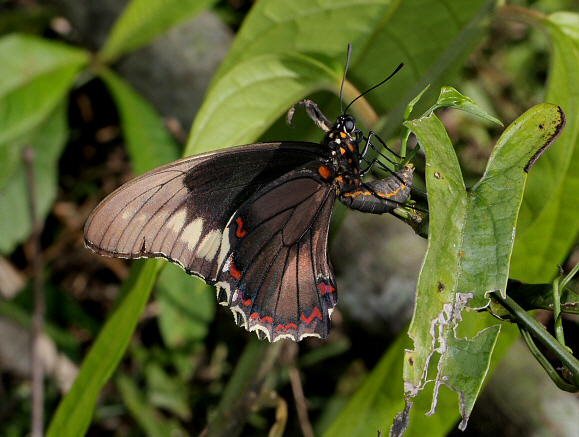
Introduction
Battus, and the related genera Parides and Euryades are not true Swallowtails, but are members of the Troidini, the same tribe to which the giant Ornithoptera Birdwings of Papua New Guinea belong.
There are 12 Battus species most of which are confined to tropical and sub-tropical areas of Central and South America. Two species however – polydamas and philenor, have ranges that extend into the southern United States.
The upper wing surface of Battus species is similar to the underside but has a slight greenish sheen and lacks the submarginal red spots. Both sexes of polydamas are similar in appearance.
Battus polydamas produces 20 subspecies occuring variously in south-east USA, on most Caribbean islands, and throughout most of Central and South America as far south as northern Chile.
Habitats
This species occurs in a wide variety of habitats including secondary rainforest, humid deciduous woodland, open scrubby grassland, coastal habitats, parks and gardens, at altitudes between sea level and about 500m.
Lifecycle
The eggs are laid in clusters of between 6-20 around the leaf stems of various Aristolochia species including fimbriata, pilosa and leuconeura. The larvae are dark red with fleshy thorn-like dorsal and lateral tubercules. Most of the tubercules are the same colour as the body but those arising dorsally from segments 6 and 10 are yellowish-orange. In the early instars the larvae feed gregariously on the underside of leaves of the foodplant. When older they disperse and feed singly. The chrysalis is leaf-like in appearance, and occurs in 2 morphs, either bright green or dull brown according to the substrate on which it is formed. It has a prominent thoracic keel, a pair of dorsal abdominal keels, and lateral keels protruding from the inner margin of the wing pads.
Adult behaviour
Males are usually encountered as singletons. They can often be seen imbibing mineralised moisture from dry river beds or from the edges of small streams. Females are seen less frequently but can sometimes be seen nectaring at Vochysia or Hamelia. In common with most other Papilionidae, all Battus species tend to rapidly flutter their wings for several minutes when feeding.
